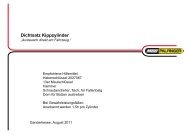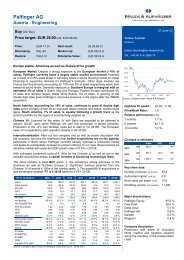palfinger at a glance
palfinger at a glance
palfinger at a glance
Create successful ePaper yourself
Turn your PDF publications into a flip-book with our unique Google optimized e-Paper software.
Economic Background<br />
Consolid<strong>at</strong>ed Management Report / Market Review<br />
> search Print<br />
Market Review<br />
Economic Background<br />
The global economic situ<strong>at</strong>ion in 2011 had two observable phases. As expected, the first half of the<br />
year was characterized by good growth. However, from mid-year onwards, the political upheavals<br />
in the Middle East and the aftereffects of the devast<strong>at</strong>ing n<strong>at</strong>ural disaster in Japan put a brake on<br />
the economic momentum. Growth in industrialized n<strong>at</strong>ions was low in the second half-year and the<br />
large public debt in individual European countries triggered a euro crisis th<strong>at</strong> took on major political<br />
dimensions in some countries and <strong>at</strong> the level of the European Union. This resulted in another rapid<br />
rise in uncertainty in the financial markets, as a result of which it has been difficult to make any<br />
projections as to the future development of business and markets.<br />
The problems in the euro area, as well as the high debt levels in Japan and the USA, impacted on<br />
the real economy in the fourth quarter of 2011, although the actual consequences will not be felt<br />
until 2012. Against this backdrop, the Intern<strong>at</strong>ional Monetary Fund (IMF) lowered its global growth<br />
forecast in January 2012, expecting the global economy to grow by 3.8 per cent in 2011 and by a<br />
mere 3.3 per cent in 2012.<br />
In Europe, the slowing of economic growth in the second half of 2011 also became increasingly evident<br />
in Germany and France, which until then had been considered the drivers of economic growth.<br />
The debt crisis in the euro area expanded, and towards the end of the year the leading economic<br />
indic<strong>at</strong>ors signalled a strong downturn. It is expected th<strong>at</strong> in 2012, the recession will not only be<br />
noticeable in Greece and Portugal, but will also hit two major players of the monetary union: Italy<br />
and Spain. The European Central Bank lowered its key interest r<strong>at</strong>e again in December, this time to<br />
1 per cent. The euro area is forecast to grow by 1.6 per cent in 2011 but to decline by 0.5 per cent<br />
in 2012.<br />
Large n<strong>at</strong>ional debt in Europe<br />
and the USA has slowed global<br />
economic growth.<br />
Central and Eastern Europe has been indirectly affected by these developments, as the euro countries<br />
are major export markets. Against this backdrop, while still expecting GDP to increase by<br />
5.1 per cent in 2011, the IMF has revised its growth forecast for 2012 downwards to 1.1 per cent.<br />
In contrast, economic performance in Russia has continued to be solid, even in the second half of<br />
2011. The high commodity prices proved to be an additional lucr<strong>at</strong>ive source of income.<br />
In the USA, the large n<strong>at</strong>ional debt and the fiscal uncertainties gave rise to insecurities among businesses<br />
and priv<strong>at</strong>e households <strong>at</strong> first, but from mid-year onwards the US economy showed a remarkably<br />
positive performance. In September, the Federal Reserve adopted another stimulus initi<strong>at</strong>ive;<br />
<strong>at</strong> 1.8 per cent each, GDP growth is expected to be weak in 2011 and 2012.<br />
Growth remained robust in L<strong>at</strong>in America, but the decline in foreign demand is likely to lead to a<br />
significant slowdown of economic performance. To counter this development, Brazil lowered its<br />
base r<strong>at</strong>e in September despite high infl<strong>at</strong>ion, and the implement<strong>at</strong>ion of additional measures was<br />
not ruled out. The IMF has forecast growth r<strong>at</strong>es of 2.9 per cent for 2011 and 3.0 per cent for 2012.<br />
44 <strong>palfinger</strong> Annual Report 2011

















